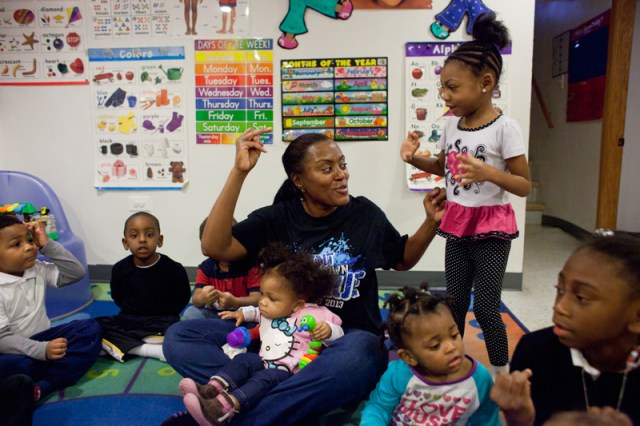CHICAGO –– Ruth Kimble has been waiting a long time for early childhood education to have its moment, and now, it seems, the moment has arrived. Across the country, voters and politicians alike are at last making pre-kindergarten expansion a priority.

That’s good news to Kimble, 66, an unassuming grandmother of four who offers both day care and preschool in a violent and impoverished section of this struggling city. But it’s not nearly enough.
Kimble has ideas, though, practical ideas about how to get society’s youngest and most vulnerable learners off to the right start. She’s carrying them out in her community, a predominantly African-American neighborhood on Chicago’s west side called Austin. And on a very small scale, she’s demonstrating promising practices for the nation at large.

Children of the working poor often spend their most pivotal years for brain development, birth to age 5, in government-subsidized day care in other people’s homes. So Kimble is simultaneously trying to professionalize the day care industry –– notorious for its high turnover and low-skilled workers –– while making more academic preschool settings available to the kids day cares serve.
On an otherwise bleak swath of Austin’s West Division Street, a royal blue awning welcomes visitors to Channing’s Childcare Academy, named after Kimble’s eldest grandchild.
Upstairs, Kimble runs the Austin Childcare Providers Network, originally intended for day care operators in the community but now attracting participants from as far away as Wisconsin. People coming to meet state training requirements at her workshops discover a wide array of resources. They pay a small membership fee, and then they can ask Kimble anything.
All day, she and an assistant field calls from day care providers and those aspiring to enter the profession, telling them where to go to learn CPR, how to attain and keep up with their licensing, how to file for state childcare subsidies. Kimble can’t improve the low wages providers receive: The average annual salary is $21,310 –– versus $30,750 for a preschool teacher and $53,030 for teaching kindergarten. But she can help fix a lack of support, in the hope of drawing good candidates to the field. She offers training in basic computer and financial literacy in addition to topics directly related to children’s education like outdoor learning activities.
Downstairs, about 70 children ages 2 to 12 come and go from 6:30 a.m. to 6 p.m. With an easygoing demeanor that belies the passion beneath, Kimble operates her own day care center as well as morning and afternoon sessions of Head Start, the federal school readiness program for 3- and 4-year-olds from low-income families.
The Head Start room looks as many other preschools do: One recent Monday, 10 children sat on a blue carpet brainstorming words that begin with the letter B. (“Boys!” “Beach!” What did the teacher just finish reading? “A book!”)
The principal of a nearby elementary school calls Ruth Kimble “the Bill Gates that no one knows about in early childhood education.”
What’s different is who’s there: Many of these kids attend competing day care establishments in the area. Their parents work long hours and cannot bring them to a preschool class, even a full-day program like what President Obama wants to see nationwide. Only day cares accommodate their schedules. So Kimble has arranged for the other providers to transport them –– with the understanding that she will not poach them for her own day care.
After getting help from Kimble in opening her home business, Marion Young now drives five of her charges to Kimble’s afternoon Head Start session. “Any questions I have concerning the business, she is there for me with concrete information,” said Young, 55, who is studying for a bachelor’s degree in early childhood education despite a work day that starts at 6:15 a.m. when the first child arrives and sometimes stretches past midnight before the last has been picked up. “It’s not a ‘you owe me.’”
Not all of Kimble’s competitors are receptive to her partnership. But Illinois is trying to encourage the sort of collaboration she promotes, providing a financial incentive for unionized home day care providers to bring low-income children to preschool under a new contract.
Kimble also has connected day cares with a local elementary school, Spencer Technology Academy. Spencer Principal Shawn Jackson said he used to view the day care businesses in the neighborhood as a threat to his Head Start program. But Kimble suggested partnering with them in 2012, when he was trying to justify funding for an additional Head Start class, and the day care providers began providing transportation.

Spencer quickly saw its Head Start enrollment increase, and in the two years since, the school’s kindergartners have been arriving more academically ready –– since more children have had access to that early preparation the year prior. In the fall of 2011, only 33 percent of Spencer’s kindergarten students arrived meeting early literacy benchmarks on a national assessment, according to data Jackson provided. By last fall, that number had increased to 65 percent.
“She opened my eyes,” Jackson said of Kimble. He called her “the Bill Gates that no one knows about in early childhood education.”
“I look at what she’s doing with early childhood, and it just seems like a great comparison,” he said. “With technology, [Gates] was the innovator. You tend to kind of forget his work, the beginning work, the grunt work.”
***
Ruth Kimble grew up in Austin. She was the fourth of nine children, and her parents ––a domestic worker and a paper factory employee ––valued education highly despite lacking it themselves.
After high school, she spent 22 years as a secretary and data entry clerk for the oil giant Amoco, working out of a downtown skyscraper. She sent her own son to day care and considered it a positive experience, but she didn’t know the value then of early education. “Back in the day, it was just babysitting,” she said.

During a downsizing in the mid-1990s, Amoco offered laid-off employees the opportunity to go back to school, and Kimble started studying for an associate’s degree. Then her sister-in-law asked for her help opening a day care business. Kimble obliged for a time, but “it really was not what I call quality,”she recalled. Her husband, who was a correctional officer before his retirement,suggested that she open her own.
Unlike many day care providers, Kimble started the process by getting a degree. In 1998, having completed an associate’s and advanced certificate in early childhood education at Malcolm X College, Kimble cleared out her basement and started rounding up neighborhood kids. She also gathered other day care providers to form an association, so they could better themselves together. And she went on to earn a bachelor’s, from Northeastern Illinois University.
In 2005, Kimble moved her day care out of her home and into the building on West Division Street, naming the business after her first grandchild, a girl named Channing who is now 19 and a freshman at Johns Hopkins University.
Right now, only a high school diploma or GED is required to run a home day care business in Illinois and many other states. (Two years of college is currently required to run a day care center.) Kimble believes many providers are held back from furthering their education because Illinois struggles to pay them promptly with their day care subsidies for low-income families. That leads to burnout because they can’t afford assistants. Other barriers include an inability to get through college-level math classes and by outstanding student loans.
But standards nationally are increasing thanks to the federal government’s Race to the Top competition offering money to states for strengthening their early childhood services. Kimble supports a push for a minimum of an associate’s degree and a basic understanding of early childhood education either by majoring in the subject or earning an advanced certificate. That’s likely to become a reality in Illinois, which won $52.5 million through the competition.
Related stories
Meanwhile, Kimble hosts workshops for day care providers two or three times a month. They count toward the 15 hours a year that the state requires for day care provider training, and with a shortage of opportunities, they draw participants from far beyond the original target audience of Austin.
At a session on outdoor learning, the 25 attendees were mostly women but a few men, ranging in age from early 20s to a woman in her late 70s known as Miss Ozzie.
The session’s goal was to get caregivers thinking about how to infuse learning and language development into everyday activities. Research has shown that children from poor families often start school behind because they aren’t exposed to the same breath of vocabulary and life experiences.
Holding brown paper bags, the participants trudged up and down North Waller Avenue, a side street off West Division, with 15 minutes to find items like a rock, a leaf, a pinecone, a piece of litter, something soft, something square and something red.
Reconvening in a room with multiplication tables and choking relief instructions posted on the wall and a blow-up globe to bounce around, the group discussed how to modify the activity for different age levels. They talked about other learning opportunities, too, from picnicking in the backyard to making butterflies out of pipe cleaners and coffee filters.
“Science is all around you,”said Camille Gant, a certified child development trainer Kimble brought in to lead the two-hour session. “There is learning going on at all times, even with the younger children. Even with the infants.”
Paulette Harvey, 46, is one day care provider who has taken that teaching to heart. Wanting the children under her supervision to learn all they can, she realizes that means she can’t teach them everything herself. They need to go to preschool. Harvey requires parents to let her bring their children to preschool when they reach age 3. Parents often are worried about all the paperwork required. She assures them she’ll handle it.
Harvey drives two of the children in her care to the morning Head Start session at Kimble’s place. One of them is Skylai Dakota Sanders, 4. Skylai’s mother, Shanta Dillard, drops the little girl off with Harvey at 6 a.m. before a long day of full-time work followed by full-time college. The three and a half-hour preschool program would be impossible for the family if not for the transportation Harvey provides.

Beyond that, Harvey incorporates activities into her day care that line up with what Skylai is learning at preschool. Before the girl starts kindergarten in the fall, Harvey’s goal is for her to recognize all shapes and colors and to be able to print her name.
“She’s learning about nine hours a day, with a nap in between,”said Dillard, 32. “She really knows the months, all the way to December. She’ll wake up and tell me it’s Thursday.”
Kimble doesn’t understand why collaboration, with its obvious payoff, isn’t more common. In her ideal system, elementary schools would communicate with preschools about what children should come in knowing, and preschools would coordinate with day care providers.
That type of work is beginning to happen in Chicago at large and Austin in particular. The principals of four area elementary schools met recently at Spencer to discuss how they can create a smoother transition to kindergarten through partnerships with local day care providers and preschools.
“It would be such a benefit for children,” Kimble said, “if everybody was on the same page.”


